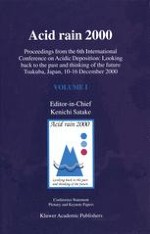2001 | OriginalPaper | Buchkapitel
Low-Co2 Energy Pathways Versus Emission Control Policies in Acidification Reduction
verfasst von : Sanna Syri, Niko Karvosenoja
Erschienen in: Acid rain 2000
Verlag: Springer Netherlands
Enthalten in: Professional Book Archive
Aktivieren Sie unsere intelligente Suche, um passende Fachinhalte oder Patente zu finden.
Wählen Sie Textabschnitte aus um mit Künstlicher Intelligenz passenden Patente zu finden. powered by
Markieren Sie Textabschnitte, um KI-gestützt weitere passende Inhalte zu finden. powered by
Integrated assessment models were applied to analyze the side-benefits of structural changes in the energy systems of Finland and the EU to reduce acidity critical load exceedances in Finland. The acidification reduction potential of structural measures, induced by the need to restrict carbon dioxide (CO2) emissions, was compared with international agreements limiting acidifying emissions. The impacts of the UN/ECE Gothenburg protocol and the European Commission’s proposal for a National Emission Ceilings (NEC) Directive were assessed together with domestic and bilateral policy scenarios. The study utilized point-source emission databases of Finland and the neighboring areas and a meso-scale deposition model together with the Europe-wide transfer matrices of the EMEP/MSC-W and European emission scenarios of IIASA. Further technical reduction measures in the adjacent large sulfur emission sources in Russia would reduce considerably deposition to nearby Finnish areas. Energy saving and shifts in the EU energy system towards less carbon-intensive fuels instead of further technical emission controls were found to have significant potential in limiting acidifying deposition. Implementation of the Kyoto protocol in the EU could reduce the Finnish areas at risk of acidification more than the Gothenburg protocol and the NEC Directive together.
